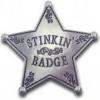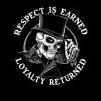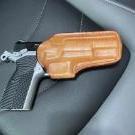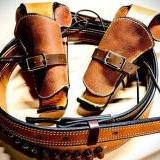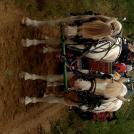-
Posts
1,065 -
Joined
-
Last visited
Profile Information
-
Gender
Male
-
Location
Colorado
-
Interests
Beer, poker, good food, comfortable shoes.
LW Info
-
Leatherwork Specialty
Retired holster maker.
-
Interested in learning about
how women think
-
How did you find leatherworker.net?
web search
Lobo's Achievements

Leatherworker.net Regular (4/4)
-
James Arness (the actor portraying Matt Dillon) was trained, like many other actors, by Arvo Ojalla, a noted holster maker and quick-draw artist of the time. The holster and belt were probably from Ojalla's shop also, as he was the source for a lot of western TV shows and movies. In the opening scene in every episode Mr. Dillon is faced off against a man for a street duel, and that part was played by Arvo Ojalla. There is a spoof version of the opening scene you can probably find on U-tube in which Dillon faces off against Ojalla, then Dillon gets shot and collapses. Otherwise, a close rendition of the usual episode opening, but Matt Dillon lying dead in the street. They were all probably having a little fun that day. James Arness was a brother to actor Peter Graves, of the original "Mission Impossible" series and some of the later movies. The original radio show "Gunsmoke" featured William Conrad (Jake and the Fat Man) as Marshal Dillon. Alongside Arness in the earlier series as his sidekick was Dennis Weaver as Chester. Later years featured Ken Curtis as Festus Hagin. Mr. Curtis grew up in Las Animas, Colorado where his father was sheriff of Bent County, and spent his teen years tending to the prisoners in the county jail overnight. Went on to a singing career with the Sons of the Pioneers prior to WW2, then went into acting with several excellent performances. I was fortunate to meet Mr. Curtis several times during the 1980s and 1990s, always found him to be a very pleasant gentleman. Just about everybody in show business had a role in a Gunsmoke episode at some time over the years. Burt Reynolds had his first significant, and recurring, role. Carroll O'Connor (All in the Family) played a number of characters. You name the actor of the period, he probably appears in Gunsmoke. Nothing about the show "Gunsmoke" is remotely authentic in terms of location, firearms, holsters, or anything else. Pure Hollywood entertainment for the masses.
-
How to do it? My suggestion is to do it very carefully. Many of the light units and laser sights are constructed of plastic that may not accept a great deal of pressure applied during the forming process. Some units have activation buttons or switches that might be damaged during the process. Other units may not be effectively water-resistant, so wet-forming may cause some problems. Other than those potential issues, I've found that many of the popular units mount either to a rail under the dust cover, or to the forward portion of the trigger guard bow. Either way that space forward of the trigger guard may no longer be exposed sufficiently to cause the pistol to remain at the desired point in the holster, perhaps allowing the holstered pistol to be pushed lower in the holster body than designed (especially with open-bottom holsters). Finally, with so many brands and types of lights and laser sights it would be very difficult (and expensive) to stock a sufficient variety to meet potential demands. A single-unit order from a local customer who can make his pistol and attachment(s) available for patterning and forming can be accommodated, but single-unit custom holsters are far more time-consuming than a general production piece for which a proven pattern is on hand. Also keeping in mind that you are responsible for any losses or damage to property of others while it is in your possession. Since these devices became somewhat common (past 10-15 years) I tried to avoid such jobs. Before retiring I was completing about 2000 pieces per year (average about 40 per week), working in batches of 10 or 12 pieces at a time going through the various steps (cutting, dying, linings, assembly, stitching, edges, forming, finishing, hardware, drying, packaging, shipping). This allowed me to complete each piece with an average of 47 minutes of shop time. Custom one-of-a-kind orders frequently require far more total time, so we can find ourselves working for very little profit in comparison to the time invested in each piece. Most jobs are interesting, some are challenging, some can just eat up a bunch of time for little or no return. My thoughts, for what they may be worth.
-
From a business point of view there is always a good market share available for utility-type holsters, designs more attuned to protecting and securing the handgun while keeping it comfortably available. An example of my usual comments about the 4 major factors of holster design; comfort, security, accessibility, concealment. Whenever one factor is emphasized there will be compromises in the other factors. Each user must determine which factor(s) are most important and how much compromise is acceptable. My time in the business was 1972 to 2015. Back in the mid-1970s I filled orders from hunters, guides, and outdoorsmen for full-flap holsters, usually for large handguns suitable for hunting or survival needs. That market remained steady over the years and as late as 2010 or 2012 I completed orders for customers literally all over the world including scientific, geological survey, oil exploration groups, most of them operating in remote areas and extreme climates. I remember another order from a motion picture production featuring pre-WW2 uniformed police officers using full-flap cross-draw holsters. Another slice of the market, somewhat similar, is chest holsters for use by hunters, backpackers, recreational vehicle users, and others. Protection and security are primary factors with accessibility and comfort also considered. For those trying to build a business it never hurts to consider product lines to meet customer needs. Many makers seem to concentrate their efforts on what appeals to themselves rather than focusing on what other people need or want. My 2 cents worth for the day.
-
I did a lot of two-layer gun belts. Had a display set up to show the variations offered, all of them about 24" in length. Not long enough for anyone to buy (or steal), but enough to show the materials and workmanship. Mr. Customer could see them and handle them, place an order, and the belt would be put on the production schedule and delivered on completion. Biggest issue on belts, in my experience, is sizing. Clothing manufacturers have used "vanity sizing" for so many years that very few people have any idea of their waist size. I wear a size 34 waist trouser, but my belts measure 37.5" from buckle attachment point to tongue hole in use. Longest belt I ever made was 67", required 77" strap length, shipped with a holster for a 6.5" Smith & Wesson .44 Magnum revolver (big dude, big gun). I always asked customers to measure a belt they were presently using, and I absolutely refused to accept returns due to sizing errors. Every buckle has a different length of the engagement; choose your buckle when you select your belt, and if you change the buckle the result is your problem, not mine. Event at that, when I retired and shut down the shop I had a couple dozen belts lying around that needed homes. I gave most away to friends and family.
-
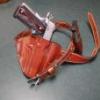
holster modification
Lobo replied to chuck123wapati's topic in Gun Holsters, Rifle Slings and Knife Sheathes
I like the idea of using the old sheep wagon. Should be a good tool to draw folks in to see what's going on. Nothing wrong with a good hat! Stetson 6X beaver felt in the winter, Resistol straw in the summer. Both are over 30 years old and still looking good! Personally, I avoided walk-ins and looky-loos, took no customers in the shop, never published my phone number, did everything via website and email. Front door closed and locked. I averaged 35 inquiries per day, each one taking 5 to 10 minutes to deal with by email. If I had walk-ins and took phone calls there would never have been enough time to get any production work done. Had a part-time assistant coming and going on her own schedule (sometimes early mornings, sometimes late evenings) doing much of the lay-out, cutting, assembly, stitching, then once each week spending 4 or 5 hours doing all the finish work at one time. My time was spent doing holster forming, edge finish, hardware, managing the website, keeping up with inventory and supplies, dealing with the emails, packaging finished orders, mailing, and carrying the loot to the bank. Couple of times each year I would have a brainstorm, spend a few hours each week for several months working on new product and design ideas. Always doing new patterns (there seems to be a new handgun on the market every other week and holster requests start to come in) which is very time-consuming, lots of changes as prototypes are made and tested. Many of my personal holsters came from product prototypes, not quite perfect but perfectly adequate for the purpose. . -

I need a belt expert
Lobo replied to Dwight's topic in Purses, Wallets, Belts and Miscellaneous Pocket Items
Agree. Maybe one end of the strap came from the belly area, variations in density, wrinkling, other potential defects. We don't always see potential irregularities in the leather until assembly, stitching, finishes applied, etc. 43 years in the business, I made a lot of chew toys for the dogs. For whatever it might be worth, I used to cut my belt straps from sides, laying out from the back to the belly and angled for the lengths I wanted. Always marked the end from the back, then when assembling two straps I alternated the two pieces so that the ends were reversed (back to belly ends). This reduced the effects of slight irregularities in thickness so the overall belt was more uniform and stronger. Usually did 5 or 6 belts per week to fill pending orders. When new shipments of leather sides arrived I laid each one out and cut a few straps from the middles, leaving two pieces that were then easier to handle when laying out holster patterns on the bench. Kept the straps for use as needed, replenishing various lengths as each size was used up. With the straps already cut it was easy to lay out all the week's belt orders and do them all at the same time (cutting, assembly, cementing, stitching, etc). Knock out 5 or 6 in a couple of hours, then they were ready to go through finishing cycles (edge burnishing, oiling, final finish, hardware) with the week's other orders (holsters, pouches, etc). Working in batches is much more time-efficient than doing single pieces from start to finish. -

holster modification
Lobo replied to chuck123wapati's topic in Gun Holsters, Rifle Slings and Knife Sheathes
Back in the early 1970s the thumb-break holsters became very popular. Many of the cops I worked with wanted their strap-snap holsters modified to thumb-break so I worked out a few designs for several popular designs. Each one took about an hour to 1.5 hours, mostly small scraps of leather, and some reinforcement for the thumb-release (local lumber yard had sturdy steel straps used to secure pallets of lumber, easy enough to cut and fit for the purpose). I charged about $5 per, back in the day. Probably did a couple hundred over the course of a few years. At the same time I was making basic pancake-style holsters for $6 each and thumb-break police duty holster for $15 each (steel shank, hand-sewn toe plug, lots of work!). Doesn't sound like very much today, but back then my take-home pay (after taxes, retirement fund, family health insurance) was $192 every two weeks, and my house payment was $182 per month. A dozen little side jobs per month made a big difference! The leather work remained a little side gig through the 1970s working uniformed patrol, through the 1980s as a detective and supervisory investigator, and until my retirement in 1995 as a chief. Kept on pounding out a few here and there until about 2006 when I discovered the internet and website marketing, then it became full-time 7 days per week for about 9 years (no days off, no weekends, no vacations, no holidays). Wore me out! Made me an old man! But it also allowed me to finally retire very comfortably, debt-free, new home, and a nice investment portfolio. Plenty of opportunity out there for people willing to work for it. But we must be careful what we wish for because sometimes we get more of it than we can handle! -

knife repairs and sheathes
Lobo replied to chuck123wapati's topic in Gun Holsters, Rifle Slings and Knife Sheathes
Over the decades I have made hundreds of sheaths for people with good knives and worn out, lost, or damaged original sheaths. I always enjoyed those little chores but seldom made much more than material costs. Very few people are willing to pay the value of a couple hours of skilled craftsmanship that is required to complete a simple knife sheath. Worked with a good custom knife maker for several years. Different proposition, doing a dozen at a time and working for a professional who understood the time and costs involved. He was charging $250 and up for his knives so he didn't mind paying a fair price for what he wanted to offer his customers. I also ended up with a few of his knives in trade for his sheath needs. -
I retired nearly 7 years ago. I offered 13 different holster designs, with or without 4 common options, left-hand or right-hand, in 4 different finish colors, for about 140 different handgun models. That equates to some 80,000 possible variations. Prices ranged from mid-$50 range to $150-plus range depending on the customer's preferences. Average sale price was $78; average materials cost was $9; packaging about $1, delivery (postage) about $4. Gross profit about $64 per piece. Always someone who wanted something else, their own design idea, a copy of someone else's design, whatever. Every week another class graduated from Holster Genius School and wanted someone to build their idea of "the perfect holster". My standard response became "$60 per hour plus materials and shop supplies". How much will that be? "I don't know, I haven't done it yet". How long will it take? "I don't know, I haven't done it yet." Doing custom work is much different than producing products to an established and proven pattern. In my shop we completed standard production items in batches of 10 to 12 at a time, usually 35 to 50 per week, with average shop time per piece at about 47 minutes. Doing a single one-off special order piece might take 6, 8, maybe 12 hours of shop time. General production products at $64 gross profit on 47 minutes of shop time equals $1.36 per minute ($81 per hour). Even if I had customer orders for custom products at $60 per hour plus materials and shop time I would have been losing money doing those orders (as long as I had pending orders for general production). I charged $25 for basketweave tooling on a holster; each piece takes about 15 minutes. My Sheridan-style floral carving artist was paid $60 per holster; I charged $90 to the customer. Remember that these figures reflect 7 years ago. Bought my home 7 years ago for $182,000; it is now worth $340,000. Bought my truck 4 years ago for $37,000; same model now is $54,000. Gasoline was $2.20 per gallon; now it is $4.89. Good Hermann Oak veg-tanned cowhide was about $4.50 sq. ft.; now it is about $8.00. Hell, 7 years ago I couldn't pick up $50 worth of groceries; now I do it with only one hand. If you are doing leather work as a hobby, filling your spare time, maybe earning a little pocket money, it's all good. But if you are running a business you must balance your capacity to produce against product demand, along with overhead costs. If you are capable of producing 10 items per week and 20 potential customers want those items your price per unit will be toward the upper end of market tolerance. There is simply no reason to accept less than what the market will bear. Since my retirement the new owners of my business have raised prices significantly, but they are still working at near their abilities to keep up with demand. More power to them! Best regards.
-
About 12 or 13 years ago I hooked up with a shop providing laser engraving services. All run from a computer program, basically any image that can be scanned into memory can be replicated in any scale. My focus as a holster maker was offering the option of military and law enforcement images, such as military unit crests, badges, etc. Customers could send me a photo or other image via email, have it replicated on the new holster. The shop doing the laser work was willing to take these on as a one-of-a-kind job for a quite reasonable fee, and the turn-around time was only days. In a year's time I think we did about 5 total orders. Wasn't worth the time dealing with customer questions and putzing around with the details (photos, links to images, endless questions). Market demand did not justify the time this little idea ate from my daily schedule. Your experience may be different.
-

One of 5 pancake holsters
Lobo replied to Hags's topic in Gun Holsters, Rifle Slings and Knife Sheathes
Very nice workmanship. Well done, sir. -

Help with Mauser HSc holster
Lobo replied to PAMuzzle's topic in Gun Holsters, Rifle Slings and Knife Sheathes
OP is in Pennsylvania, son with the pistol is in Missouri. I ran into that situation several times, people wanting a holster made for a pistol I did not have and no dummy gun available. The choices were: 1. Purchase a pistol. This is viable only when there is significant demand and more orders to be expected. 2. Mr. Customer can send his pistol to me via a Federal Firearms License holder, pay the shipping both ways, pay the FFL transfer fees at both ends. Usually requires next-day air service, which is a bit expensive ($75 or so each way). Many FFL holders will do the transfers and charge $25 to $50 or so for each transfer. Another scenario is a new handgun model announced by a major maker (happens every couple of weeks for the past 15 years or so). Lots of people wanting holsters for their new guns, but no dummy guns (probably won't be seen for a year, if ever, depending on market demand). Dummies are usually available only for current production handguns that have achieved a large market share; new models and older models are seldom seen. I bought a lot of guns over the years. Most paid off over time. Some sat in the gun safe for months or years with no orders coming in. As soon as I used one to pattern and form a holster for sale the gun itself is a tax-deductible business expense (here in the USA anyway), so I looked at it as building my retirement fund with tax-free money. After retiring I sold most of them, usually making a tidy profit (which is recaptured depreciation, treated as capital gains for tax purposes with very preferential tax treatment). A few customers sent their custom or one-of-a-kind handguns to me. I really did not like to have them on hand because of the liability for loss or damages (my business insurance policy had a $1000 deductible). Considerable risk to assume for a single holster order. I thought about obtaining a Federal Firearms License so I could receive and transfer firearms in accordance with the law. But then my shop would be subject to inspection and audit at any time, and every firearm on the premises would have to be treated as inventory, recorded in the bound book, records of every transfer, background checks, all the other hassles. More intrusion than I was willing to accept. -

My Latest: Glock chest holster
Lobo replied to Dwight's topic in Gun Holsters, Rifle Slings and Knife Sheathes
Very nice design and execution. I especially like the articulated connections allowing the straps to move with the body. A lot of thought and planning went into that project. -
Good idea on the leather belt loop. Another approach I have used in the past for competition holsters (and police duty holsters) is reinforcing the holster back and the belt loop using strips of 20 to 24-gauge galvanized sheet metal (some HVAC shops will give away scraps, but you want the heavy stuff instead of the lighter metal typically used for duct work), and later with Kydex. A small panel encased in the holster back panel will keep the holster rigid and resist flexing over time. A strip encased in the belt loop from the holster attachment point upward and underneath the belt will keep the holster at a consistent angle and positioning. Assembly can be done with rivets or T-nuts and machine screws through both reinforced areas making a very strong connection. I came to like the Kydex for this use. Easy to cut and shape, warm it up with a heat gun and pre-form it to any contour or angle you like to establish carry angle and offset from the body. On duty holsters with thumb-break retention a small strip of Kydex can be incorporated in the thumb-break as reinforcement. Kydex is very durable, impervious to moisture, and is dirt cheap (used to be under $2 per square foot, and that is enough for multiple projects). Some of the competition and duty handguns can be quite heavy and that weight puts a lot of stress on the leather, over time causing excessive flexing and softening at the stress points.
-

My Roy Rogers version
Lobo replied to Thescandall's topic in Gun Holsters, Rifle Slings and Knife Sheathes
One stitch per second is like "light speed" for those of us who hand-stitched everything for many years. I remember spending hours at a time stitching up a few holsters at a time, tearing the skin off my fingers followed by aches and pains in my hands, wrists, and arms. The day I received my Cobra Class 4 stitching machine was a wonderful day. Work that used to take the better part of an hour could be done in a few minutes, minus all the aches and pains, waking up in the morning with claws for hands that couldn't hold a coffee cup. Carpal tunnel surgeries. Cubital tunnel surgeries. Permanent damage to the ulnar nerves in both arms. Anti-inflammatory medications as a daily regimen. Prior to my retirement in 2015 I was filling 40 orders every week. Totally impossible without a power stitching machine. Still have to force my fingers to get any function during the first hour or two every day. 43 years in the business, 35 part-time and 8 full-time. Made a lot of money and retired very comfortably, but I'm still paying the price for that now.




